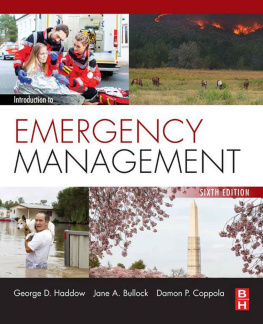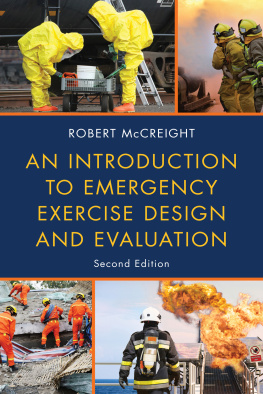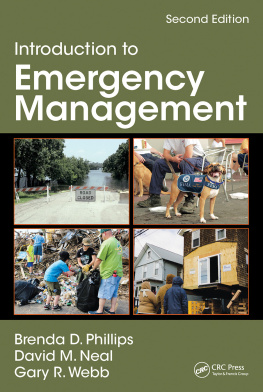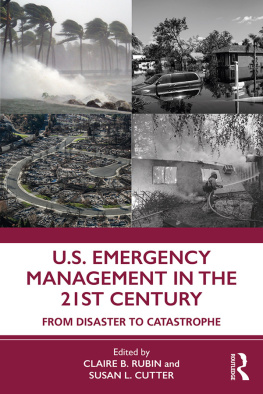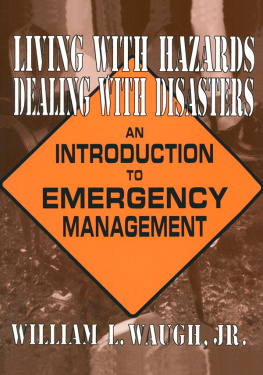George Haddow - Introduction to Emergency Management
Here you can read online George Haddow - Introduction to Emergency Management full text of the book (entire story) in english for free. Download pdf and epub, get meaning, cover and reviews about this ebook. year: 2017, publisher: Butterworth-Heinemann, genre: History / Science. Description of the work, (preface) as well as reviews are available. Best literature library LitArk.com created for fans of good reading and offers a wide selection of genres:
Romance novel
Science fiction
Adventure
Detective
Science
History
Home and family
Prose
Art
Politics
Computer
Non-fiction
Religion
Business
Children
Humor
Choose a favorite category and find really read worthwhile books. Enjoy immersion in the world of imagination, feel the emotions of the characters or learn something new for yourself, make an fascinating discovery.
- Book:Introduction to Emergency Management
- Author:
- Publisher:Butterworth-Heinemann
- Genre:
- Year:2017
- Rating:5 / 5
- Favourites:Add to favourites
- Your mark:
- 100
- 1
- 2
- 3
- 4
- 5
Introduction to Emergency Management: summary, description and annotation
We offer to read an annotation, description, summary or preface (depends on what the author of the book "Introduction to Emergency Management" wrote himself). If you haven't found the necessary information about the book — write in the comments, we will try to find it.
Introduction to Emergency Management — read online for free the complete book (whole text) full work
Below is the text of the book, divided by pages. System saving the place of the last page read, allows you to conveniently read the book "Introduction to Emergency Management" online for free, without having to search again every time where you left off. Put a bookmark, and you can go to the page where you finished reading at any time.
Font size:
Interval:
Bookmark:
Sixth Edition
George D. Haddow
Jane A. Bullock
Damon P. Coppola

Butterworth-Heinemann is an imprint of Elsevier
The Boulevard, Langford Lane, Kidlington, Oxford OX5 1GB, United Kingdom
50 Hampshire Street, 5th Floor, Cambridge, MA 02139, United States
Copyright 2017 Elsevier Inc. All rights reserved.
No part of this publication may be reproduced or transmitted in any form or by any means, electronic or mechanical, including photocopying, recording, or any information storage and retrieval system, without permission in writing from the publisher. Details on how to seek permission, further information about the Publishers permissions policies and our arrangements with organizations such as the Copyright Clearance Center and the Copyright Licensing Agency, can be found at our website: www.elsevier.com/permissions.
This book and the individual contributions contained in it are protected under copyright by the Publisher (other than as may be noted herein).
Notices
Knowledge and best practice in this field are constantly changing. As new research and experience broaden our understanding, changes in research methods, professional practices, or medical treatment may become necessary.
Practitioners and researchers must always rely on their own experience and knowledge in evaluating and using any information, methods, compounds, or experiments described herein. In using such information or methods they should be mindful of their own safety and the safety of others, including parties for whom they have a professional responsibility.
To the fullest extent of the law, neither the Publisher nor the authors, contributors, or editors, assume any liability for any injury and/or damage to persons or property as a matter of products liability, negligence or otherwise, or from any use or operation of any methods, products, instructions, or ideas contained in the material herein.
British Library Cataloging-in-Publication Data
A catalog record for this book is available from the British Library
Library of Congress Cataloging-in-Publication Data
A catalog record for this book is available from the Library of Congress
ISBN: 978-0-12-803064-6
For Information on all Butterworth-Heinemann publications visit our website at https://www.elsevier.com/

Publisher: Katey Birtcher
Acquisition Editor: Steve Merken
Editorial Project Manager: Nate McFadden
Production Project Manager: Priya Kumaraguruparan
Designer: Gregory Harris
Typeset by MPS Limited, Chennai, India
The authors dedicate this book to Chief Rich Marinucci. Rich brought a visionary leadership to the US Fire Service that improved the safety of Americas 1.15 million firefighters and helped to educate all Americans about the critical role that fire personnel play in our everyday lives. His commitment to bridging the gap between the fire and emergency management communities increased the resilience of towns and cities nationwide. Rich remains an inspiration and a friend to all of us.
Brad Gair, Vice President Emergency Management and Enterprise Resilience, NYU Langone Medical Center, New York, NY, United States
Twenty-five years ago when I started out in emergency management, most of us were only part-time emergency managers and had other larger responsibilities in our organizations. In my case, it was building roads, bridges, and flood control projects in rural Arizona. When a disaster happened, we stopped whatever we were working on, managed the emergency, and then went back to our regular work.
We did the best we could with the time we could allocate to the profession, but in those days, there were few places to turn to for formal guidance. There were a couple of places where you could get a college degree in emergency management, and if you looked hard enough you might find some useful information in various books and journal articles, but there was nothing comprehensive.
All of this changed post-9/11 and again post-Hurricane Katrina. Our nation has had to adapt to the growing threat of more frequent, more costly, and more complex disasters. Terrorists are no longer just faraway adversaries plotting large-scale attacks; today they may also be from any of our own communities, planning and executing small but effective attacks that kill and injure dozens. Warmer oceans and higher sea levels mean that powerful hurricanes are increasingly capable of impacting major population centers and causing damages at unprecedented levels. Now with our dependence on technology growing exponentially, anyone with a computer and some basic cyber skills can already cause significant disruptions, and in the coming years will be able to wreak devastation at a vastly disproportionate scale. Add to this the ongoing substantive risk of nuclear, biological, electromagnetic pulse, and other natural and manmade crises, and disaster management can be an extremely daunting task.
Fortunately, as the challenges have grown, so has our emergency management profession. We now have a network of seasoned, full-time emergency managers across the country, many of whom have gained broad experience in preparing for and dealing with major disasters in recent years. We share our knowledge, our hard-learned lessons, and our best practices, and are now considered to be part of one of the fastest growing and most critical sectors nationwide.
Emergency managers traditionally found their way into the business, rather than selecting emergency management as their vocation. All of that has changed. There are now hundreds of colleges and universities in the United States and around the world offering degrees in emergency management, national security, and related fields. The next generation of emergency managers will have purposefully selected this career and will be better prepared than their predecessors to use the tools, technologies, and strategies needed for the future.
The one thing that has not changed is the basics of emergency management. No matter how complex and difficult the threats become, we still have to start with our proven processes: we have to prepare for all-hazards, including planning, training, and exercises; we have to respond effectively and efficiently making certain that we have the proper command, control, communication and coordination mechanisms in place; we need to understand recovery processes and programs to help our communities build back better and stronger after a disaster; and perhaps most importantly, we need to find new and innovative ways to make our communities and our nation more resilient to a wide variety of hazards.
To accomplish this, our next generation of emergency managers needs a foundational resource that teaches the key principles of emergency management and what it truly means to be an emergency manager. Since 2003, Introduction to Emergency Management has been that resource. Now in this sixth edition, George Haddow, Jane Bullock, and Damon Coppola have closely studied current trends in emergency management, reviewed lessons learned from recent major disasters, and analyzed the emerging threats of the future to create this latest edition of the definitive textbook on the subject, used in institutions of higher education worldwide.
Font size:
Interval:
Bookmark:
Similar books «Introduction to Emergency Management»
Look at similar books to Introduction to Emergency Management. We have selected literature similar in name and meaning in the hope of providing readers with more options to find new, interesting, not yet read works.
Discussion, reviews of the book Introduction to Emergency Management and just readers' own opinions. Leave your comments, write what you think about the work, its meaning or the main characters. Specify what exactly you liked and what you didn't like, and why you think so.

